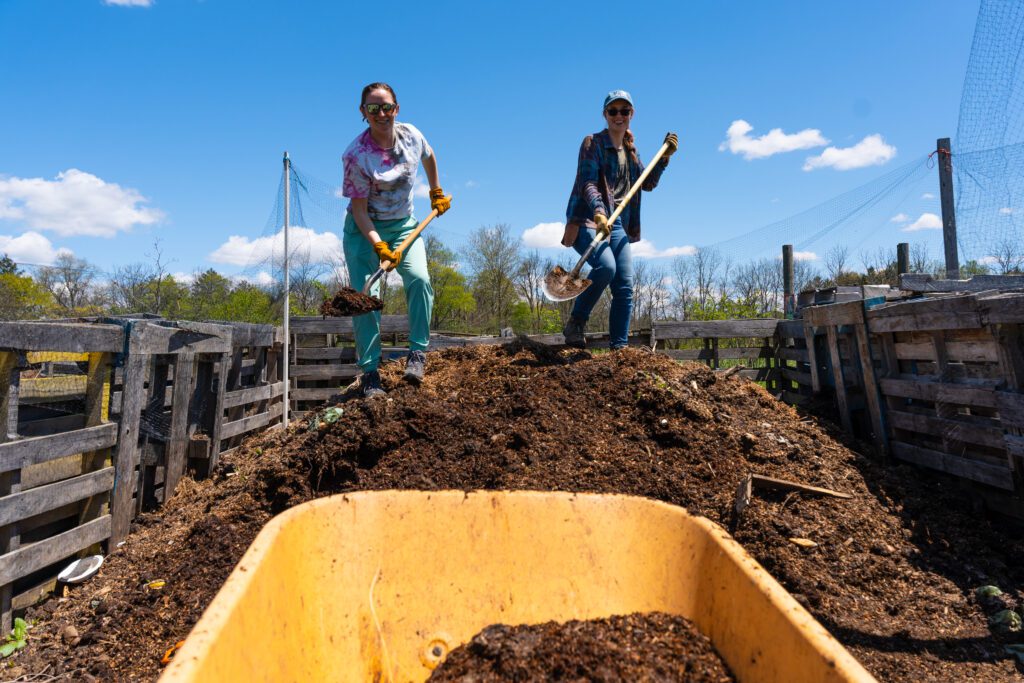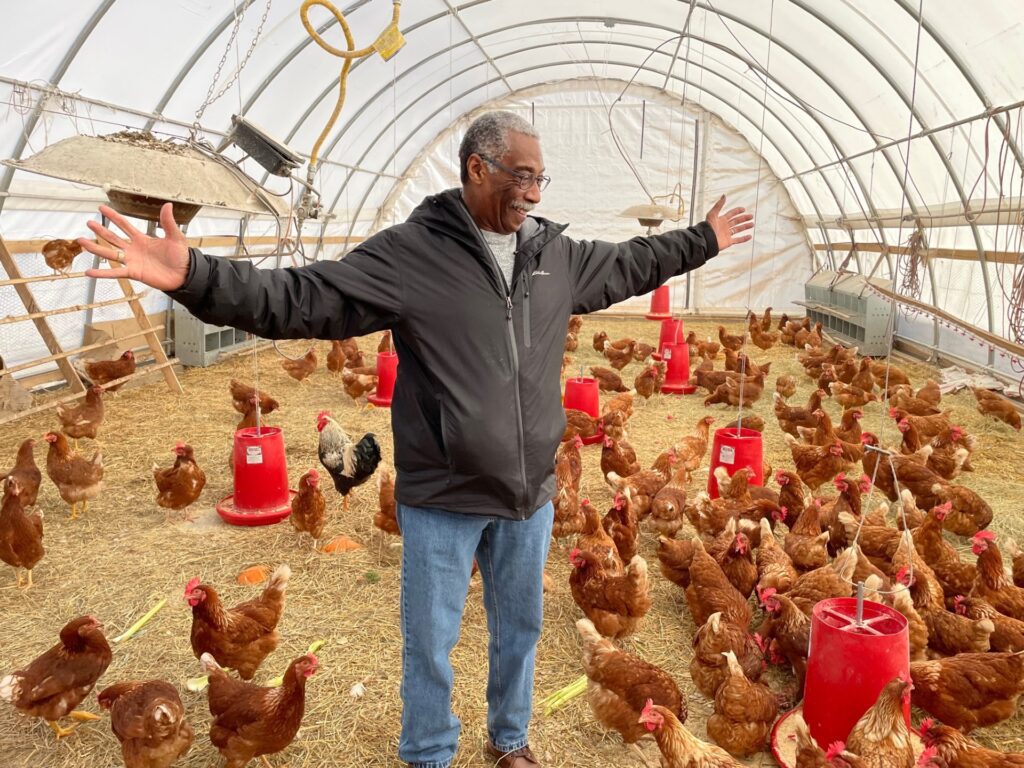
A new study led by an Earlham College faculty-student research team reveals that while regenerative agriculture is viewed by farmers as a promising path forward for soil health and community wellbeing, widespread adoption in the Midwest is being held back by a lack of information, financial support and shared resources.
“For farmers in our area, there’s a gap between how beneficial these practices are seen as and how common they are on the landscape,” said Jaime Coon, assistant professor of biology and environmental sustainability at Earlham, on the four-year research endeavor. “So, the motivation is there. But farmers say they need help getting started — with grant programs, community support, and opportunities to learn from each other.”
Coon and 2024 Earlham graduate Mary Jo (MJ) Easley are the lead authors of “Farmer Perceptions of Regenerative Agriculture in the Corn Belt: Exploring Motivations and Barriers to Adoption,” recently published in the international peer-reviewed journal Agriculture and Human Values. Their research examines how early adopters of regenerative practices near the Indiana-Ohio border define regenerative agriculture and what barriers to adoption look like.
Easley, now a pursuing a Master of Science in Sustainability Management at the University of Toronto Mississauga on scholarship from the Fulbright Graduate Studies program, began the research as a sophomore on campus. The project became a four-year collaboration with Coon and additional Earlham collaborators, including Gene Hambrick, senior executive director of the Center for Entrepreneurship, Innovation and Creativity, and Jenny Williams, office manager and administrative assistant for the Epic Centers CoLab.
The team conducted surveys and in-depth interviews with dozens of early adopters of regenerative practices, with a focus on examining areas that are rural, economically depressed and where agriculture remains central to the local economy.
Interviewees cited motivations like improving soil health, protecting water quality, enhancing biodiversity, and sustaining family farms. Many of those interviewed saw a direct link between environmental practices and community wellbeing.
“For me, this work is about recentralizing the farmers in the regenerative agriculture conversation,” Easley said. “Too often, it’s top-down — big corporations leading the dialogue. “But farmers know their land. There’s real value in what they’re already doing and they know what they need to be doing more of.”
Barriers, however, were consistent: high start-up costs, lack of financial incentives, and limited local support networks. Practices like cover cropping and low-till methods were more common, while costlier, more effortful strategies like livestock integration remained out of reach for many.
“We expected to hear about some tension between environmental and economic goals,” Coon said. “But most farmers rejected that dichotomy. They want to leave the land better than they found it — they just want help managing the short-term start-up costs.”
The study’s grassroots approach was intentional. “Many efforts to improve agriculture come from outside communities, trying to ‘fix’ them,” Coon said. “But we wanted to listen. Farmers are the experts of their own land. It’s our job to lift up their insights, not replace them.”
The project began thanks to Hambrick, who connected Easley — then a student interested in food systems — with a new initiative between Earlham and Fayette County officials focused on sustainable agriculture. The connection began as an internship about sustainable farming before evolving into something bigger. Williams later joined the effort to transcribe the extensive interviews, which often lasted more than an hour, and was a proofreader and editor of the submitted research.
“Mary Jo was doing graduate-level work from the start,” Coon said. “This was a huge commitment over four years, and she brought a remarkable level of care and curiosity to it.”
Now pursuing a career at the intersection of business, policy, and sustainability, Easley credits Earlham’s interdisciplinary ethos for helping her combine her interests in economics, farming, and environmental justice.
“We need more spaces like this — where business, science, and lived experience can inform real solutions,” Easley said. “That’s what made this project so meaningful.”
Coon added: “The interdisciplinary education that we offer at Earlham is a powerful thing and you can see it in Mary Jo’s career trajectory. Research projects like this one that embrace insights from the qualitative social sciences are one way we can devise polices and solutions to real world challenges. The goal is to provide information that policy could be built upon.”
The research was funded and made publicly available as an open-source document courtesy of a startup established by Coon and a discretionary fund managed by Earlham’s Center for Entrepreneurship, Innovation and Creativity.
Laying the groundwork for an agribusiness innovation hub
This research has already helped catalyze a broader initiative through Earlham’s Center for Entrepreneurship, Innovation and Creativity, where Hambrick is now leading an effort to launch the Agribusiness Innovation Hub Initiative. Drawing on lessons from the research project, the initiative seeks to create a sustainable business model that supports young farmers and rural communities in adopting regenerative practices.
“This all started with a question about agribusiness and rural internet,” Hambrick said. “But with Jaime’s guidance, we pivoted toward regenerative farming. What we learned was that it’s not enough to talk about ideals — we have to talk about culture, communication, and yield. You need a value proposition that makes sense to the farmers of today.”

“The future of farming lies with younger growers who are open to innovation. If we can support their success through regenerative models — and connect them with funding, business tools, and each other — we can help transform rural economies in a lasting way.”
— Gene Hambrick, senior executive director of the Earlham Center for Entrepreneurship, Innovation and Creativity
The Hub aims to address the start-up challenges identified in the study by connecting farmers with market research, mentorship, technical assistance, and access to financial support. Fayette County, a rural, under-resourced county, may serve as the pilot site, with plans to expand to other under-resourced agricultural communities across Indiana.
Hambrick sees this as an opportunity for Earlham to play a leadership role in developing solutions at the intersection of education, entrepreneurship and agriculture. “This isn’t just about sustainability — it’s about building something that can support itself financially, provide value to the community, and give Earlham students like MJ a real-world context to apply their learning.”
A central component of the next phase will be educational outreach. “The future of farming lies with younger growers who are open to innovation,” Hambrick said. “If we can support their success through regenerative models — and connect them with funding, business tools, and each other — we can help transform rural economies in a lasting way.”
The Agribusiness Innovation Hub Initiative is currently in development, with plans to secure grant support, refine its business model, and formally launch in the upcoming academic year.
Media contact
Brian Zimmerman
Assistant vice president of marketing and communications
Email: [email protected]
Phone: 765.983.1256